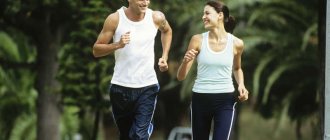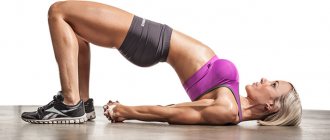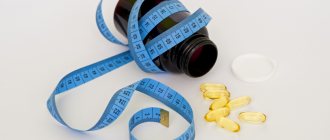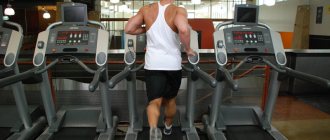Let's start with the fact that you can get rid of fat in a week. Yes, we approve. Yes, it's that simple. No smart words or abstruse advice from nutritionists who only work for them. In this post, the editors of Bow&Tie will talk about how to get rid of fat for you personally. Our advice will help in 100% of cases any person who does not have hormonal disorders. They helped us. And absolutely everyone who tried them, too.
Fat breakdown is a chemical reaction, and Bow&Tie will tell you how to start it.
Nutrition rules - following them, you will lose weight
Nothing in the human body comes from nowhere and goes nowhere.
The less often a person eats, the more the body does to reduce energy loss. In addition to the lack of effect (weight loss), a person experiences weakness and gets tired quickly. The solution to a slow metabolism is to eat fewer calories, but eat more often. We divide the daily calorie requirement into 5-7 meals during the day. In this case, the body will not respond to a decrease in caloric intake, since it will understand that it is not in danger of prolonged fasting.
The following nutritional algorithms will help you.
What is EPOC and its role in weight loss?
You may have heard of a phenomenon called EPOC, which stands for excess post-exercise oxygen consumption. This is the period when your body recovers from exercise and burns calories faster than at rest. Some trainers talk a lot about EPOC, claiming that it's better than steady-state cardio because it allows you to burn calories while you're doing nothing (similar to how building muscle affects your metabolism). But the truth is that the EPOC effect is not that great.
According to the ACSM, we burn only 6% more calories during EPOC than during the actual workout (more if you ran very intensely—harder than most people are capable of, but still not that much).
So is cardio just a huge waste of time? Of course not. It still burns fat and improves endurance, and more importantly for your health, it strengthens your heart, lowers your blood pressure, helps you recover faster from strength training, and does many other beneficial things. But the fact remains that any exercise, when done without changing your diet, does not make much difference in weight loss.
See detailed instructions on how to implement each cardio method and enjoy your summer.
Fractional meals
The principle of fractional nutrition is maintaining a balance of proteins, fats, carbohydrates, vitamins and minerals while reducing daily caloric intake. To do this, food is divided into 5-7 meals.
Let's give an example of a nutrition schedule and products that were personally tested in practice and gave a positive result at the rate of 1,500-2,000 kcal per day:
Carbohydrates:
- rice, buckwheat, oatmeal and pearl barley, etc. – 100-250 grams (start the day with the largest portion and eat everything before 15:00, otherwise the body will not have time to spend it).
Proteins:
- boiled chicken breast – 400-500 grams (save for at least one evening meal);
- boiled eggs – 3-5 pieces (also leave 1-2 for the evening);
- low-fat cottage cheese – 200 grams (eat at the last meal);
- low-fat kefir - 1 glass (also at the last meal).
Fiber is vegetables, you can eat them within reason (but at the last meal - only cottage cheese and kefir). Fats – we suggest betting on fish oil capsules (Omega-3). Drink at least 3 liters of regular, still water per day.
After a week of eating like this, weigh yourself. If:
- Nothing happened or you gained weight – no big deal. This means you consumed as many calories as you burned, or more. Reduce your diet by 50-100 grams of carbohydrates.
- We lost 1-1.5 kilograms - great, the fat is disappearing.
- Losing 2 or more kilograms of weight is very bad, not only fat is lost, but also muscle. Add 50-100 grams of carbohydrates to your diet.
Weigh yourself weekly and monitor your diet so that you do not lose more than 1.5 kilograms during the week. Next, if you want, diversify your diet by calculating calories using any calorie tables.
Cardio for weight loss 1-4 weeks
Treadmill workout
- 3-5 minutes, 1 repetition
- Body part: Quadriceps Equipment: Exercise
Treadmill workout
- Walking on a treadmill. 2 minutes of fast walking, 2 minutes of walking at medium speed. This will be 1 approach. Do 3 of these sets and increase the number of repetitions every week until you reach 5-7
- Body part: Quadriceps Equipment: Exercise
Treadmill workout
- Walking on a treadmill. 3-5 minutes of easy walking at low speed.
- Body part: Quadriceps Equipment: Exercise
Add to Calendar * Add to My Workouts * Print Workout
* — The service is in beta testing
Cyclical no-carbohydrate diet
A low-carbohydrate diet is considered effective, but it is not suitable for everyone.
The essence of the diet is eating in cycles. We exclude carbohydrates from the diet for 2-5 days, and then eat only carbohydrates for 1-2 days (so that the body does not switch to a slow metabolism).
Be sure to weigh yourself every day and record your results to determine when the weight will stop coming off. This is important: most often the metabolism slows down for 3-4 days, but this is not true for every organism.
We suggest starting with the system: 3 days - no carbohydrates, 1 day - only carbohydrates. Next, if you feel good and the weight is coming off, increase the number of days without carbohydrates. If you feel bad, reduce the number of days without carbohydrates and increase the number of carbohydrate days.
Days without carbohydrates:
- boiled chicken breast or fish – 500-600 grams;
- boiled eggs - 10 pieces;
- low-fat cottage cheese – 300 grams;
- vegetables – 400-500 grams.
Carbohydrate days:
- rice, buckwheat, oatmeal and pearl barley, etc. – 100-250 grams;
- Protein and fiber – within reasonable limits (i.e. don’t overeat).
This diet is considered the most effective, but is not suitable for everyone. If you do not have time to restore strength during carbohydrate days, you feel lethargic and powerless, add chocolate or honey to your cereal. If this doesn't help, this diet is not for you.
What does "cardio training" mean?
Doing cardio means doing physical exercises that increase your heart rate. As a result of such activity, the functioning of the heart muscle and vascular system improves, endurance develops, and the metabolic process is activated.
There are many types of cardio exercises. The most popular are the following: rowing and aerobics, jumping rope, swimming, running, skiing. In one hour of such training, from 400 to 600 kilocalories are consumed. Cardio is often presented as the best way to fight extra pounds and fat, which is not entirely true.
If you don’t have money for proper nutrition and diets
The above diets cannot be classified as budget ones. Another option is to distribute your own standard daily meals into 6-7 meals a day. A week after weighing, determine the results.
If you gain weight or remain at the same level, reduce carbohydrates by calculating your nutrition using any calorie table. If you have lost more than 1.5 kg, add carbohydrates or, for example, eat a chocolate bar a day. If you have lost 1-1.5 kg, everything is great.
Cardio training to burn fat
The mechanism for getting rid of fat deposits starts after the depletion of glycogen, the carbohydrate stored by the muscles. This can be achieved by doing cardio for at least forty-five minutes or immediately after completing core strength training.
The role of sport in the process of losing weight should not be overestimated. Eliminating junk food from your diet and reducing your overall calorie intake to a moderate level brings much more noticeable results. It is easier to avoid an excess of calories than to deal with the consequences of excessive or improper nutrition.
Cardio training for weight loss at home and outdoors
Cardio training is divided into high-intensity and low-intensity
Cardio training - walking, jogging, swimming, cycling, exercise on an exercise bike, jumping rope, etc. There are two sources of energy in the muscles:
- Glycogen is the carbohydrates that are burned first. It lasts on average 40 minutes.
- Fat is not subcutaneous, but muscle fat. It is spent either when glycogen is released, or when slow muscle fibers are involved. It also lasts for 40 minutes on average.
During such cardio exercises the following happens:
- fat “burns” (first glycogen, then fats from the muscles, and when they come out, subcutaneous fat is “wasted”);
- blood circulation increases;
- the cardiovascular system is strengthened.
The overall endurance of the body also increases.
Cardio training outdoors
Cardio workouts are divided into high-intensity (very fast running, fast cycling) and low-intensity (fast walking). The more intense the load, the more carbohydrates are burned and the less fat is burned. With low intensity (when slow muscle fibers are involved), on the contrary, fat immediately “burns”.
Does this mean that brisk walking is more effective than running in burning fat? On the one hand, yes. But on the other hand, the more intense the load, the more energy (calories) will be spent during recovery. That's why:
- High-intensity cardio training will help you quickly “burn” fat, but with additional stress.
- low-intensity cardio workouts will also help “burn” fat, but more slowly.
Therefore, if time is not critical, or if you do strength training, you can avoid exposing yourself to additional stress and preserve muscle (more on this below).
Cardio training at home
We perform cardio training at home with an open window and in a well-ventilated room (so that the body is saturated with oxygen, and oxygen oxidizes fat in the body). The following exercises are suitable:
- riding an exercise bike;
- jumping rope;
- rotation of the hoop;
- slow running in place;
- gymnastics.
You need to do cardio training at home for at least 40-50 minutes without a break, in a ventilated area, while monitoring your pulse (more on this below).
Running (burns about 600 calories per hour)
Running is very efficient compared to walking (we don't mean sprinting now, that's anaerobic activity). This is a good way to lose fat and improve your own heart health.
The main benefit of running for fat loss is more calories lost, stimulating your metabolism over a longer period of time.
The main benefit of running for fat loss is more calories lost.
Jogging is most suitable for fat burning, since during it a person does not cross the anaerobic threshold and does not begin to burn carbohydrates as a primary resource. Running, like walking, involves the entire lower body, only to a greater extent.
It improves the shape of your hip flexors, hamstrings, quads and calves. Running also uses your arms, which burns even more calories.
Running is used for the following purposes:
- To train at higher intensity and burn more fat in the end
- To engage leg muscle tissue, which improves their shape
- As a special way to improve your overall fitness level
- To increase metabolism for up to 24 hours
- Helps avoid osteoporosis.
Program for beginners:
- Frequency: three times a week
- Intensity: 65-85%
- Duration: 20-30 minutes
Bicycle (burns about 600 calories per hour)
Cycling uses the same muscles as running, but has the added benefit of putting less strain on the muscles, so it's suitable for almost everyone (except those with injuries).
It can be done both on a simulator and on a real bike.
Although this activity is suitable for almost everyone (regardless of goals), you can choose your own resistance level to achieve your intensity goals. The bike is good for HIIT as the resistance level easily changes from high to low. For bodybuilders, cycling is good because it forms the frontal muscles of the quadriceps and they are better separated.
The bicycle is used for the following purposes:
- How High-Intensity Cardio to Burn Fat
- How sport can improve overall health
- As a way to improve the shape of your quadriceps.
Program for beginners:
- Frequency: three times a week
- Intensity: 65-85%
- Duration: 30-45 minutes.
Rowing
Rowing is a great full-body exercise and a good way to burn body fat. This is an ideal exercise for all major muscle groups, and the intensity is higher than walking. It's safer than running and burns more calories than any other form of cardio (about 840 calories per hour).
Rowing can be used for the following purposes:
- Burn more calories than any other cardio
- This is a full body exercise
- It is safe and helps burn fat
- Improves overall health
Swimming (burns about 600 calories per hour)
Like rowing, swimming is a great full-body exercise that burns a lot of calories. It is also safe because the body is in a special environment (water) and the risk of injury is low.
Swimming freestyle is fine for most people, but if you want to target specific muscles, use a variety of strokes.
Swimming is an ideal aerobic exercise for:
- Reduce the risk of injury
- Works on all major muscle groups
- Improvements in general health
- Burning more calories
Jumping rope
This is also a very good cardio exercise. It is very good for your calves and shoulders as it works them strongly. This is perhaps the most difficult form of cardio as it requires skill, strength, concentration and attention when done correctly.
It's not often used as cardio, but it burns even more calories than rowing (over 1000) and is very good for short sessions. On the other hand, jumping rope can cause leg injury.
Advantages of the jump rope:
- burns a large number of calories
- helps prevent osteoporosis
- involves a huge number of skills and abilities, including explosive strength, endurance and speed (jumping rope is a mandatory part of boxer training).
HIIT
HIIT (High Intensity Interval Training) is the new and most effective way to burn fat.
As the name suggests, HIIT involves both high-intensity aerobic work for maximum fat-burning effects and an elevated metabolic rate that lasts for 24 hours after the workout.
Regular cardio makes the body addictive. This means that the body adapts to the speed and tries to conserve the waste of calories. But with HIIT this is simply not possible as the intensity changes almost every minute.
Sample HIIT workout:
Using a bike, work at a medium to high intensity (75-80%) for 2 minutes. Quickly change the intensity to a more severe intensity (greater than 90%) for 30 seconds or 1 minute. Repeat all this for 30 minutes. You can also run, row or swim using the same system.
What are the benefits of HIIT?
- The HIIT system will increase the fat-burning hormones epinephrine and norepinephrine.
- Reduces insulin levels.
- Raises metabolic levels higher than any other form of cardio.
How to combine cardio and strength training for weight loss - options for beginners and amateurs
Strength and cardio can and should be combined.
We suggest considering two options for combining cardio + strength. Option number 1 – for those who have time to train:
- Step 1 – 40-50 minutes of low-intensity cardio training (muscle fat goes away).
- Step 2 – 20-50 minutes of strength training to trigger lipolysis with the help of stress and anabolic hormones.
- Step 3 – 1 hour of rest (to allow blood flow to deliver fat to muscles).
- Step 4 – repeat steps 1 and 2.
Option number 2 – for people who don’t have time:
- Step 1 – 40-50 minutes of low-intensity cardio in the morning. For example, walking at a brisk pace on an empty stomach (muscle fat goes away + in the morning there is not so much “own” fat in the muscles).
- Step 2 – 40-50 minutes of low-intensity cardio training before strength training (muscle fat goes away).
- Step 3 – 20-50 minutes of strength training to trigger lipolysis with the help of stress and anabolic hormones.
- Step 4 – 40-50 minutes of low-intensity cardio after strength training (for example, a brisk walk home).
You can add low-intensity cardio training whenever possible.
Benefits of Cardio
All forms of aerobic training provide the same benefits, regardless of intensity.
To determine the intensity level you need, you need to calculate your maximum and minimum heart rate levels. The lower edge is 55% of the maximum. The upper limit is 80%. Simply subtract your age from 220, and then multiply the result by 0.55 and 0.8.
Aerobic exercise (regardless of intensity) helps:
- Strengthen the muscles responsible for breathing to help your lungs
- Increase your total red blood cell count
- Strengthen the heart muscle
- Reduce tension and stress, improve mental health
- Increase blood circulation throughout the body
- Improve self-esteem.
Low intensity cardio exercise (50-75%) - benefits:
- Will put less strain on joints, making them ideal for people who are overweight
- Burn fat, can be performed for a long period\
- Can be used as a way to recover from more intense techniques.
High Intensity Cardio Exercise (70-85%) - Benefits:
- Will burn more calories and more fat in the end
- Will increase metabolic rate (during and after exercise) compared to low-intensity cardio
- Improve endurance, strength
- Helps prevent osteoporosis.
How and why to monitor your pulse
The correct pulse will allow the body to be saturated with oxygen and oxidize fats.
You need to control that the pulse level within 110-160 beats per minute (true for young, healthy people, deadly for the elderly) will allow the body to be saturated with oxygen, which will oxidize fats. If the pulse drops to 60-90 beats per minute, the body will begin to “burn” not fat, but glycogen.
The maximum permissible heart rate level for your body can be calculated using the formula 205.8 - (0.685 x the number of years lived) = round the result down to whole numbers. Thus, for a 30-year-old man, the maximum allowable heart rate is 185 beats per minute, so a range of 110-160 is acceptable.
We are waiting for you in the comments. We will try to answer questions and help.










